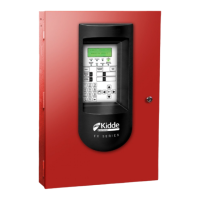Chapter 2: Front panel programming
54 P/N 3102352-EN • REV 005 • ISS 28DEC18
Description
For a remote switch that when activated, silences the signaling devices.
Two-wire smoke detector activations are verified (delayed and confirmed)
before activating an alarm. Four-wire smoke detectors and contact devices
are not verified and are considered alarm immediately.
For connecting vane type and pressure flow switches. Activations are
considered as alarms. A 16-second alarm delay applies to waterflow
activations. Circuit cannot be restored until devices are restored to normal
and the panel is reset. Waterflow activations do not invoke in-suite signal
silence. [1]
For connecting vane type and pressure flow switches. Activations are
considered as alarms. No alarm delay applies to waterflow activations for
this device type. Circuit cannot be restored until devices are restored to
normal and the panel is reset. Waterflow activations do not invoke in suite
signal silence. [1]
Waterflow No Delay Class A
For connecting vane type and pressure flow switches in a Class A circuit.
Activations are considered as alarms. No alarm delay applies to waterflow
activations for this device type. Circuit cannot be restored until devices are
restored to normal and the panel is reset. Waterflow activations do not
invoke in suite signal silence. [1]
[1] Supports Standalone mode of operation.
Table 14: Supervisory device types
Description
Duct supervisory (latching and
nonlatching)
For duct supervisory devices. Momentary activation of normally open devices
immediately places the panel in a supervisory state and turns on supervisory
LEDs and relays. Circuit cannot be restored until devices are restored to normal
and the panel is reset. Resetting the panel is not required for nonlatching.
For supervisory devices. Momentary activation of normally open devices
immediately places the panel in a supervisory state and turns on supervisory
LEDs and relays. Circuit cannot be restored until devices are restored to normal
and the panel is reset.
For supervisory devices. Momentary activation of normally open devices
immediately places the panel in a supervisory state and turns on the supervisory
LED and relay. Annunciation remains active until the input restores. The panel
does not have to be reset.
Table 15: Trouble device types
Description
AC fail For use with auxiliary power supplies to provide AC Fail indication to the fire
panel. The fire panel treats this activation as if the panel itself detected an AC fail
condition. Delays off-premises signaling for the selected time duration.

